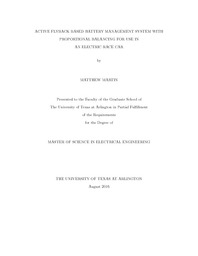
ATTENTION: The works hosted here are being migrated to a new repository that will consolidate resources, improve discoverability, and better show UTA's research impact on the global community. We will update authors as the migration progresses. Please see MavMatrix for more information.
Show simple item record
| dc.contributor.advisor | Wetz Jr., David A. | |
| dc.creator | Martin, Matthew | |
| dc.date.accessioned | 2016-10-25T19:30:32Z | |
| dc.date.available | 2016-10-25T19:30:32Z | |
| dc.date.created | 2016-08 | |
| dc.date.issued | 2016-08-08 | |
| dc.date.submitted | August 2016 | |
| dc.identifier.uri | http://hdl.handle.net/10106/26125 | |
| dc.description.abstract | Battery management systems are responsible for many tasks, most important of which is maintaining balance amongst the cells in a series string to prevent excess aging and unsafe operating conditions \cite{WhyBMS1}\cite{WhyBMS2}. In lithium-ion battery packs, traditionally, and almost exclusively in the world at large today, balancing is achieved by switching a resistor in parallel with high cells to bleed energy out of them and dissipate it as heat. This tactic is not only 100 percent inefficient, but it is slow due to power dissipation restrictions typically thermally imposed within a system, and it is only effective at preventing over-voltage conditions. This thesis serves to outline the design, simulation, and implementation of an active battery management system for deployment in an electric race car, such as to minimize battery requirements (and therefore weight), optimize aging, and maximize the usable capacity of a given battery pack. High level simulations were performed from a pure energy transfer perspective to assess the potential of such a system, showing a strong inclination towards the potential effectiveness of the system. Given the unique constraints imposed on the isolated DC/DC converters used to transfer energy within the battery string, low level simulations were performed to validate the feasibility from a hardware perspective. Hardware that supports up to 2.5A balance currents was designed, constructed, and objectively validated against the simulations. An embedded operating system was developed, with a modular hardware abstraction layer, a flexible scheduler, and many support functions, on which an active battery management state machine was built. Lastly, tests were performed in order to compare real world results to high and low level simulation results. Findings have shown that active balancing is not only more effective at bleeding off high cells during recharge imbalance, but balancing can be performed throughout the entire cycle to supplement weak cells in order to extend the capacity of the battery as well as to offset the aging rate towards the stronger cells. | |
| dc.format.mimetype | application/pdf | |
| dc.language.iso | en_US | |
| dc.subject | Battery management systems | |
| dc.subject | Lithium-ion battery | |
| dc.subject | Flyback | |
| dc.title | ACTIVE FLYBACK BASED BATTERY MANAGEMENT SYSTEM WITH PROPORTIONAL BALANCING FOR USE IN AN ELECTRIC RACE CAR | |
| dc.type | Thesis | |
| dc.degree.department | Electrical Engineering | |
| dc.degree.name | Master of Science in Electrical Engineering | |
| dc.date.updated | 2016-10-25T19:32:39Z | |
| thesis.degree.department | Electrical Engineering | |
| thesis.degree.grantor | The University of Texas at Arlington | |
| thesis.degree.level | Masters | |
| thesis.degree.name | Master of Science in Electrical Engineering | |
| dc.type.material | text | |
Files in this item
- Name:
- MARTIN-THESIS-2016.pdf
- Size:
- 8.860Mb
- Format:
- PDF
This item appears in the following Collection(s)
Show simple item record


